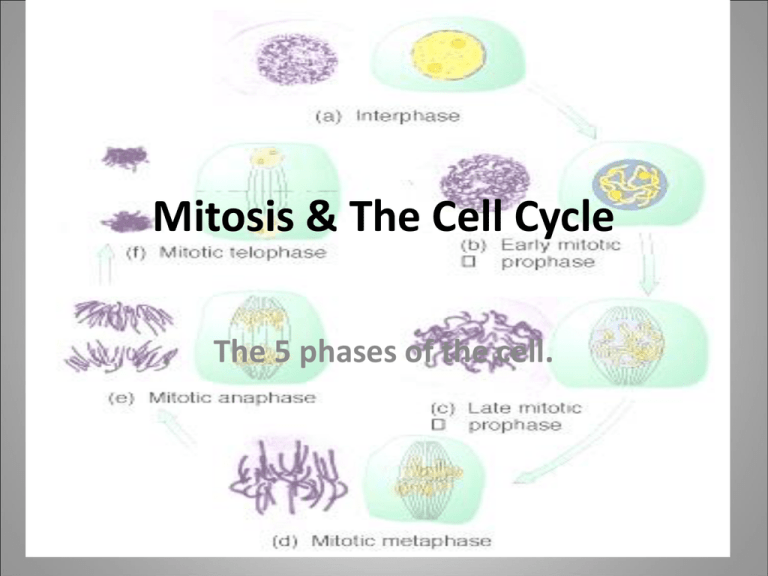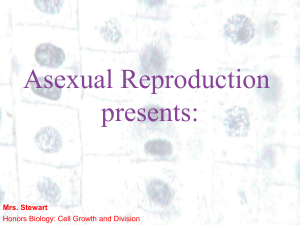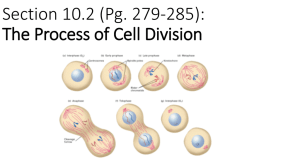
Mitosis & The Cell Cycle
The 5 phases of the cell.
Refresher on DNA
• DNA is the master molecule of the cell. DNA
is located in the nucleus of nearly every cell.
http://www.3dscience.com/img/Products/3D_Models/Biology/DNA/DNA_w_Phosphate_stru
cture/Supporting_images/3d_model_DNA_w_phosphate_1.jpg
DNA
Refresher on DNA
• Genes are sections of DNA that are typically
about 5000 nucleotides long. Genes are the
directions for making a certain kind of protein
for the cell.
http://z.about.com/d/p/440/e/f/9344.jpg
DNA
Gene
Refresher on DNA
• Chromosomes are rod-shaped structures that
contain long sections of DNA with hundreds of
genes. Chromosomes can only be seen right
before and during cell division.
• During the other phases of the cell’s life, the
DNA uncoils somewhat and exists as
chromatin which is not visible with a light
microscope.
DNA
Gene
Chromosome
Chromosomes vs. Chromatin
http://www.microscopyuk.org.uk/mag/imgnov04macro/metaphase.jpg
http://images.google.com/images?gbv=2&svnu
m=10&hl=en&q=nucleus+TEM+chromatin
Human Chromosomes (46)
http://131.229.114.77/microscopy/images/Chromosomes2.jpg
Development of an Embryo
• The adult human
body contains an
estimated 100
trillion cells.
Therefore, we are
considered to be
multicellular
organisms.
Development of an Embryo
• DNA is extremely important! DNA molecules
are needed to store the directions on how to
make new cells and to tell those new cells
what their function within the body will be.
However, every cell in the body has identical
DNA.
Differentiation
• If every cell has identical DNA, why don’t all of
the cells look and act the same? Because not
all of the DNA is used. Various sections of the
DNA are activated from one type of cell to
the next.
• This process of creating different cells using
identical DNA is called differentiation.
Cell Division
Activation of
certain genes
Differentiation
http://scienceblogs.com/clock/upload/2006/12/a2%20cell%20differentiation.gif
Differentiation
• So when, and how does a cell develop and
differentiate? The process begins with the cell
cycle.
• Recall that all of us started out as one cell, a
combination of egg and sperm. During
development, cells first divide and later will
begin to differentiate to form various body
parts.
The Cell Cycle
• As we develop, our cells go through a cycle of events. The
basic cell cycle looks like this:
Phases of the Cell Cycle
• M = Mitosis (& cell division) or sometimes Meiosis (making of
gametes/sex cells).
• G1 = Gap 1 During this phase cells are not resting! They are
busy making proteins, breaking down toxic molecules, and
using energy.
• S = DNA replication or synthesis. During this phase the cell
must make an extra copy of DNA to prepare for mitosis.
• G2 = Gap 2 During this phase cells are again not resting! They
are busy preparing for cell division.
Differentiation
• At first, cells go through
the cell cycle rapidly and
do not have time to
differentiate, but at
some point in
development the cells
stop dividing and begin
to differentiate into
different types of cells.
(In other words, they
remain in the G1 phase.)
Differentiation
• Some cells in the
human body divide our
entire lifetime. Our
hair follicles, skin, and
the lining of our
digestive tract are
examples of cells that
constantly divide.
These cells are fairly
simple and mainly
serve as barriers or
boundaries.
Differentiation
• Some cells completely
lose their ability to
divide. Once they
differentiate, they can
no longer go back to
this cycle. Muscle cells
and cells of the central
nervous system cannot
be replaced once they
are destroyed because
of this.
Differentiation
• Some cells remain in
the G1 phase most
of the time. They
can regain their
ability to divide
temporarily in order
to replace damaged
cells, but will then
go back into a mode
of not dividing.
Differentiation (or lack of)
• Cancer: a simplified explanation of cancer cells is
that these are cells that have gone into a rapid,
repetitive cell cycle. Cells normally have
mechanisms to prevent this from happening, but if a
number of these preventative measures fail, cells can
begin to multiply uncontrollably. Cancer cells do not
have time to differentiate. They look different, do
not function normally, and eventually squeeze out
the normal cells that surround them. Cancer cells
have a cell cycle that’s gone bad!
The 5 phases of the cell
• There are 5 recognizable phases of the cell:
IPMAT
•
•
•
•
•
I = Interphase
P = Prophase
M = Metaphase
A = Anaphase
T = Telophase
Interphase
• Interphase includes the G1, S, and G2 cell
cycle phases.
• Cells spend most of their time in interphase.
The only time that a cell can be seen in one of
the other 4 phases is when the cell is in the
process of dividing.
Mitosis
• Mitosis is paired with cell division:
– Mitosis refers to the process when the
chromosomes divide.
– Cell division often refers to the process when the
remainder of the cell (cytoplasm) divides, but this
term can be used more generally as well.
• Mitosis includes: prophase, metaphase,
anaphase, and telophase.
Interphase: most of the
time the cell looks like
this.
Mitosis:
The 4 phases
of mitosis can
be easily
identified
using a
microscope.
#1
• Which of these is prophase, metaphase, anaphase,
telophase, and interphase?
http://www.sep.alquds.edu/biology/scripts/Biology_english/part_3_4_files/image010.jpg
#2
• Is this interphase, prophase, metaphase, anaphase,
or telophase?
http://biology.nebrwesleyan.edu/benham/mitosis/images/alliumtelophase.JPG
#3
• Is this interphase, prophase, metaphase, anaphase,
or telophase?
http://www.instr.science.ru.nl/lichtmicroscoop/bf-division.jpg
#4
• What phase is this?
http://www.instr.science.ru.nl/lichtmicroscoop/bf-division.jpg
#5
• What phase is this?
http://chsweb.lr.k12.nj.us/psidelsky/onion_root_tip__1000_X__-10.jpg
#6
• What phase is this?
http://kcfac.kilgore.cc.tx.us/kcap1/images/whitefish%20mitosis%20telophase%201000x%20%20fireworks.jpg
#7
• What phase is this?
http://virtual.yosemite.cc.ca.us/randerson/Lynn's%20Bioslides/86.jpg
#8
• What phase is this?
http://virtual.yosemite.cc.ca.us/randerson/Lynn's%20Bioslides/94.jpg
#9
• What phases are these?
E
A
G
C
F
D
H
B
http://www.phschool.com/science/biology_place/labbench/lab3/images/anifield.gif










